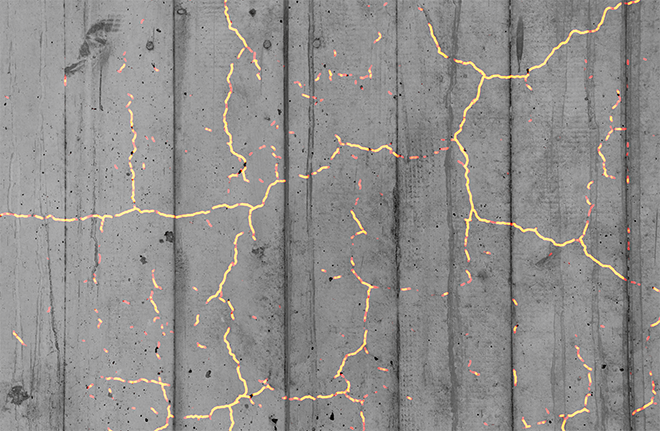Subproject: Automatic image analysis for damage detection

Problem
Visually recognizable damage to the surface of a structure is an indicator of possible impairment of load-bearing capacity and serviceability. The time-consuming and cost-intensive manual inspection of structures can be significantly supported by image analysis. Automated methods allow the processing of a large number of high-resolution images, add objectivity to the inspection process and enable complete and standardized documentation.
Project objectives
In this subproject, high-resolution images from building surveys are analyzed automatically. The main focus will be on crack detection on concrete surfaces. However, in the further development of the machine learning methods investigated, care must be taken to ensure that transfer to the detection of other anomalies on building surfaces, e.g. rust plumes, is relatively easy.
The anomalies detected in the image must be appropriately located and made visible on the object surface both for the purpose of interactive visualization in the cloud-based software environment and for final documentation and evaluation. For this purpose, the sensor orientation determined by Structure-from-Motion (SfM) can be used to directly relate individual image contents to the reconstructed 3D object model by means of raycasting.
Results
An image database of annotated cracks is created as a training basis for supervised machine learning, allowing successive training and a continuous increase in recognition rates. A supervised machine learning method with a network architecture specifically adapted for crack analysis is provided.
In addition, a learned crack model directly applicable for detection is developed. The automatic anomaly detection algorithms will be integrated into the cloud-based software platform and made available for structural inspection along with 3D location of damage.
Project duration
06/2020 – 09/2022
Contact
- Coordinator: GMTIB
Prof. Dr. Guido Morgenthal
Wilhelm-Külz-Str. 22
99423 Weimar - Subproject: Volker Rodehorst, Anton Frolov
Projekt partners
- Engineering office Probst GmbH, Meiningen
- Thuringian State Office for Construction and Transport (TLBV)
Funding program
- Promotion of Research, Technology and Innovation (FTI) of the Thuringian Development Bank (TAB)
The project supported by the Free State of Thuringia was co-financed by funds of the European Union within the framework of the European Regional Development Fund (ERDF).

